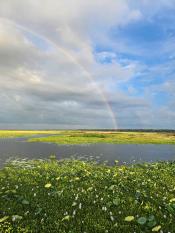
National Prairie Day is the perfect occasion to reflect on a distinct, local treasure: Payne’s Prairie Preserve State Park. You probably know Payne’s Prairie as a beautiful, natural area just southeast of Gainesville; you might have walked the observation boardwalk off of US 441, hiked the savannah in search of bison and wild horses, or joined an Alachua Audubon Society on a birdwatching tour among the oak hammocks. But you may not know all of what makes Payne’s Prairie truly special, and just why the site is so significant for Florida’s wildlife, ecology, and history.

Payne’s Prairie spans some 21,000 acres of prairies, but also marshes, savannahs, and hardwood hammocks. The park sits in the center of the Paynes Prairie Basin, where waters empty through the Alachua Sink deep below the surface. The “sink” is actually a sinkhole, which is typically blocked by sediments, but does come “unplugged” on occasion, draining the basin and opening grazing land for bison and wild horses. When plugged, water levels on the prairie vary greatly according to the weather. In fact, in 1871, heavy rains turned the prairie into a giant lake that was used heavily as a shipping route—until the plug shifted and the prairie drained once again in 1892.
Payne’s Prairie Basin was an important source of freshwater long before this brief shipping boom. For thousands of years, it attracted hundreds of species of birds, including snowbirds and permanent residents, as well as larger game animals like mammoths, mastodons, and giant armadillos that brought the first Ice Age hunters to the area. The oak hammocks surrounding the prairie also provided acorns, nuts, berries, and small game—a cornucopia for the nomadic tribes that eventually settled there. Finally, the basin itself provided a further boon: as the earth collapsed into various sinkholes, including the Alachua Sink, it exposed underground limestone that indigenous people used to make tools and weapons.
Eventually, the Potano, a tribe of the Timucua people, settled on the Prairie to grow crops and hunt, developing a complex, structured society that was well-integrated with other Florida tribes. They welcomed the early Spanish explorers who built a string of missions and ranches across the state, often working as ranch hands—making them some of the first cowboys in America! The Potano may have even rescued a ranch owner who had been kidnapped by French pirates in the late 1600s and returned him safety.
However, the territory soon changed ownership: English settlers, aided by Creek people from the north, raided and destroyed the Spanish missions and chased the survivors to the safety of coastal forts. There are no known Timucua today. These migrating Creeks came to be known as “Seminoles,” a combination of the Spanish word cimarron for “renegade” and the Muscogee simanoli, meaning “he who camps at a distance.” Seminole chiefs inherited the abandoned cattle from the La Chua ranch at Payne’s Prairie.
One chief especially embraced the new role of ‘cattle baron,’ calling himself, “The Cow Keeper”; his later descendant, “King Payne,” ruled the tribe for many years before he was killed in a spontaneous skirmish against US troops led by Daniel Noonan—whose career was memorialized in the former town of Newnansville, and the still-present Newnan’s Lake just northeast of the Prairie.
A series of Seminole Wars in the early 1900s redefined the human landscape of Payne’s Prairie once again: as the US acquired Florida from Spain, US troops killed and forcibly removed Seminoles to Oklahoma, while holdouts fled south to the Everglades.

The Prairie featured prominently in the Second Seminole War of 1835, during which 3,000 Seminole warriors fiercely defended against 30,000 US troops for seven years before the war ended without a formal peace treaty.
Though the original peoples are gone, the natural flora and fauna they saw at Payne’s Prairie 250 years ago is still there today! This is due to the diligent work of the Florida State Park Service and the Alachua Conservation Trust, both of whom work to restore and preserve all of the specific plant- and animal species that were first documented in the area in 1791, by naturalist William Bartram in his much celebrated book, Travels (known by its shortened title). To match his descriptions, the park service even imported bison and wild horses from Oklahoma, which you can still see on the Prairie today.
Why not take a few hours and have a look for yourself? Stroll the Ecopassage Observation Boardwalk off US 441; wind the Bolen Bluff Trail through the oaks just to the south; or spend the night at Puc Puggy, a campsite bearing William Bartram’s Seminole name, which means “flower hunter.” There’s no better place to celebrate National Prairie Day!